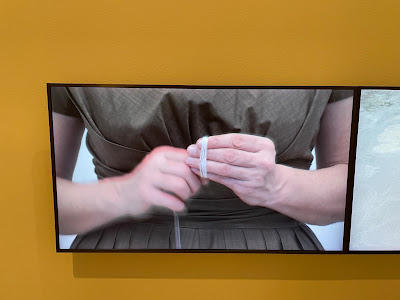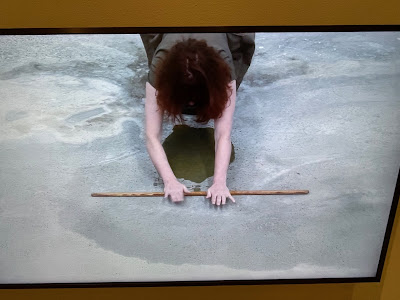Diasporic Encounters in Australia
(Art Gallery of New South Wales, Sydney)
Eugenia Raskopoulos
Czechoslovakia/Greece/Australia b 1959
re-ma(r)king 2010
dual-channel digital video, 5:15 mins
"On the left-hand screen the artist unravels a crocheted dolly, winding the threads into a ball and restoring the hand-crafted object to its material origins. On the right she drips olive oil onto the concrete floor, spreading it with a rolling pin traditionally used to make tiropita (Greek pastries) these slow meditative actions reveal the power of mnemonic triggers to bring the past into the present."
In Eugene Raskopoulos's videos the material past that the artist handles connects with tradition; gendered tradition given that a dolly and a rolling pin most commonly involved female labor.
The dolly and the pin could be objects of affect and social intimacy for the artist; things she inherited from the mother, a grandmother, or a female kin. Or perhaps just objects associated with traditional female labor which will be readily recognized by Greek viewers.
We often speak of tradition as preservation. But, clearly, we know, the next generation may turn its back on traditions that feel out of place in their lives. Women's rejection of pasts that confined women in the domestic sphere or oppressed women is not an unusual occurrence among the next generation.
But rejection is not the only route for dealing with tradition. Reworking the meaning of the material past is another. Changing its usage and meanings, making it meaningful, this meaningful re-signification for the present we often call heritage.
The title of the video––re-ma(r)king––lets out that much, the artist is shown in a process of remaking as well as remarking the significance of traditional objects. In addition, on the right-hand screen, reusing them for a purpose other than the originally intended one.
Reusing, remaking ,and remarking, the latter term in a twofold sense: re-marking (as in re-signifying, or, even better, it seems, reconfiguring its semantic and literal terrain of usage) and remarking as a creative evocative remark about her relationship with this inheritance, the dolly and the rolling pit.
Let us follow the body movements on each screen carefully (see images below):
On the left-hand screen, the body of the next generation unmakes the labor of an ancestor (or the labor of a woman from the past). The body works patiently, systematically, dismantling the original handwork, made surely with skill, as expected, and inherited knowledge from an ancestor. The body introduces a point of rupture from the past as at the same time creates a moment of continuity by retrieving––reassembling––the original form of the material.
 |
This is the point where she meets the earlier creator in a temporal confluence achieved by the original material capped by her hands. An immediate encounter not in the act of making tradition but in the act of unmaking it at the present moment; it is as if this moment is asking us (by the artist poised to be asking herself), and now what? What do I make out of this material that I recovered from tradition? Do I have an obligation to this material that connects me with the past––perhaps an affective past––as it marks and remarks and remakes discontinuity from that past connecting me thus with the maker before she turns the raw material into a traditional dolly?
The question drips from the tightly, meticulously reassembled ball of threads: and now what, what do I make with it, if anything, and why? For what purpose?
A poignant moment inviting the next generation to reflect about ways of animating the past even if this means to encounter it––to hold it––in a tightly woven, solid mass.
***
As for the video on the right-hand sight, i will leave the reading to you, the reader, this radical re-usage of two traditional items, one liquid (the dripping oil––from the mouth of the artists one wonders?) the other sturdy, calling the body to stretch even seemingly beyond its limits. Reproducing the rhythms of female labor producing sustenance for the family...
The video made me recall images from a play I saw in Melbourne, The Life of Byron. Discarding doilies from the family's immigrant trunk opened the story about a second-generation male character negotiating the place of old world in his Greek Australian life. It also made me think of a museum exhibit and the corresponding article by Artemis Leontis on the changing meaning of women's handwork among daughters and granddaughters of immigrants.
All three together, the video, the play, the article would have made an excellent opening for a class reflecting on the next generation beyond common tropes of identity making as preservation, pointing to processes of agency, reinventing a diasporic self via rejecting tradition or (re)ma(r)king heritage.
Yiorgos Anagnostou
November 18, 2023
p.s. an extended analysis could benefit from the notion of the body as archive.
Yiorgos Anagnostou
November 18, 2023
p.s. an extended analysis could benefit from the notion of the body as archive.
Comments from my fb posting:
Artemis Leontis: Bodies archive not only trauma but movement, procedure, hands meeting other handed, moving through machines, handling needles, feeling time pass or not, tongues move, words fly by or assault, being in the presence of, knowing and not knowing, feeling peace, wanting something else.
Transformation is ongoing, between receiving and decomposing and before that passing things along.
Meanwhile there are all the beautiful things that the older generation made, so much of it thrown away. A sign of the value the women never found. There’s an interesting bibliography in indigenous. studies.
Adrianne Kalfopoulou: Fascinating Yiorgos, thank you, & Artemis’ response as well. I think how the body travels w/in physical geographies of place can somehow repurpose how it archives memory. Acts of generational inheritance might become newly immediate rather than enacted as homage to tradition if that makes any sense.








No comments:
Post a Comment